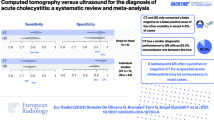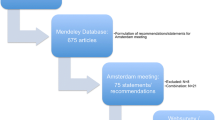Abstract
Purpose
Recently, bail-out cholecystectomy (BOC) during laparoscopic cholecystectomy to avoid severe complications, such as vasculobiliary injury, has become widely used and increased in prevalence. However, current predictive factors or scoring systems are insufficient. Therefore, in this study, we aimed to test the validity of existing scoring systems and determine a suitable cutoff value for predicting BOC.
Methods
We retrospectively assessed 305 patients who underwent laparoscopic cholecystectomy and divided them into a total cholecystectomy group (n = 265) and a BOC group (n = 40). Preoperative and operative findings were collected, and cutoff values for the existing scoring systems (Kama’s and Nassar’s) were modified using a prospectively maintained database.
Results
The BOC rate was 13% with no severe complications. A logistic regression analysis revealed that the Kama’s score (odds ratio, 0.93; 95% confidence interval 0.91–0.96; P < 0.01) was an independent predictor of BOC. A cutoff value of 6.5 points gave an area under the curve of 0.81, with a sensitivity of 87% and a specificity of 67%.
Conclusions
Kama’s difficulty scoring system with a modified cutoff value (6.5 points) is effective for predicting BOC.


Similar content being viewed by others
Abbreviations
- LC:
-
Laparoscopic cholecystectomy
- GB:
-
Gallbladder
- BDI:
-
Bile duct injury
- VBI:
-
Vasculo-biliary injury
- CVS:
-
Critical view of safety
- BOC:
-
Bail-out cholecystectomy
- STC:
-
Subtotal cholecystectomy
- LTC:
-
Laparoscopic total cholecystectomy
- ROC:
-
Receiver-operating characteristic
- AUC:
-
Area under the curve
References
Wakabayashi G, Iwashita Y, Hibi T, Takada T, Strasberg SM, Asbun HJ, et al. Tokyo Guidelines 2018: surgical management of acute cholecystitis: safe steps in laparoscopic cholecystectomy for acute cholecystitis (with videos). J Hepatobiliary Pancreat Sci. 2018;25:73–86.
Törnqvist B, Zheng Z, Ye W, Waage A, Nilsson M. Long-term effects of iatrogenic bile duct injury during cholecystectomy. Clin Gastroenterol Hepatol. 2009;7(9):1013–8.
Törnqvist B, Waage A, Zheng Z, Ye W, Nilsson M. Severity of acute cholecystitis and risk of iatrogenic bile duct injury during cholecystectomy, a population-based case-ontrol study. World J Surg. 2016;40:1060–7.
Nzenwa IC, Mesri M, Lunevicius R. Risks associated with subtotal cholecystectomy and the factors influencing them: A systematic review and meta-analysis of 85 studies published between 1985 and 2020. Surgery. 2021;170:1014–23.
Liu CL, Fan ST, Lai EC, Lo CM, Chu KM. Factors affecting conversion of laparoscopic cholecystectomy to open surgery. Arch Surg. 1996;131:98–101.
Kama NA, Doganay M, Dolapci M, Reis E, Atli M, Kologlu M. Risk factors resulting in conversion of laparoscopic cholecystectomy to open surgery. Surg Endosc. 2001;15(9):965–8.
Kama NA, Kologlu M, Doganay M, Reis E, Atli M, Dolapci M. A risk score for conversion from laparoscopic to open cholecystectomy. Am J Surg. 2001;181:520–5.
Bourgouin S, Mancini J, Monchal T, Calvary R, Bordes J, Balandraud P. How to predict difficult laparoscopic cholecystectomy? Proposal for a simple preoperative scoring system. Am J Surg. 2016;212:873–81.
Philip Rothman J, Burcharth J, Pommergaard HC, Viereck S, Rosenberg J. Preoperative risk factors for conversion of laparoscopic cholecystectomy to open surgery-A systematic review and meta-analysis of observational studies. Dig Surg. 2016;33:414–23.
Nassar AHM, Hodson J, Ng HJ, Vohra RS, Katbeh T, Zino S, et al. Predicting the difficult laparoscopic cholecystectomy: development and validation of a pre-operative risk score using an objective operative difficulty grading system. Surg Endosc. 2020;34:4549–61.
Ishizaki Y, Miwa K, Yoshimoto J, Sugo H, Kawasaki S. Conversion of elective laparoscopic to open cholecystectomy between 1993 and 2004. Br J Surg. 2006;93:987–91.
Sabour AF, Matsushima K, Love BE, Alicuben ET, Schellenberg MA, Inaba K, et al. Nationwide trends in the use of subtotal cholecystectomy for acute cholecystitis. Surgery. 2020;167:569–74.
LeCompte MT, Robbins KJ, Williams GA, Sanford DE, Hammill CW, Fields RC, et al. Less is more in the difficult gallbladder: recent evolution of subtotal cholecystectomy in a single HPB unit. Surg Endosc. 2021;35:3249–57.
Strasberg SM, Pucci MJ, Brunt LM, Deziel DJ. Subtotal Cholecystectomy-"Fenestrating" vs “reconstituting” subtypes and the prevention of bile duct injury: Definition of the optimal procedure in difficult operative conditions. J Am Coll Surg. 2016;222:89–96.
Pucher PH, Brunt LM, Davies N, Linsk A, Munshi A, Rodriguez HA, et al. Outcome trends and safety measures after 30 years of laparoscopic cholecystectomy: a systematic review and pooled data analysis. Surg Endosc. 2018;32:2175–83.
Nakajima J, Sasaki A, Obuchi T, Baba S, Nitta H, Wakabayashi G. Laparoscopic subtotal cholecystectomy for severe cholecystitis. Surg Today. 2009;39:870–5.
Strasberg SM, Gouma DJ. “Extreme” vasculobiliary injuries: association with fundus-down cholecystectomy in severely inflamed gallbladders. HPB (Oxford). 2012;14:1–8.
Matsumoto M, Abe K, Futagawa Y, Furukawa K, Haruki K, Onda S, et al. New scoring system for prediction of surgical difficulty during laparoscopic cholecystectomy after percutaneous transhepatic gallbladder drainage. Ann Gastroenterol Surg. 2022;6:296–306.
Yoshida MC, Ogami T, Ho K, Bui EX, Khedr S, Chen CC. Patient and surgeon factors contributing to bailout cholecystectomies: a single-institutional retrospective analysis. Surg Endosc. 2022;36:6696–704.
Calkins B, Chininis J, Williams GA, Sanford DE, Hammill CW. Development of a novel intraoperative difficulty score for minimally invasive cholecystectomy. HPB (Oxford). 2021;23:1025–9.
Nassar AHM, Zanati HE, Ng HJ, Khan KS, Wood C. Open conversion in laparoscopic cholecystectomy and bile duct exploration: subspecialisation safely reduces the conversion rates. Surg Endosc. 2022;36:550–8.
Funding
The authors declare that this research was conducted in the absence of any commercial or financial relationships.
Author information
Authors and Affiliations
Contributions
RI, RY, YG, and AS contributed to the study conception and design. RI and YG collected data. RI performed the statistical analyses. All authors were responsible for interpreting the data, writing the manuscript, and approving the manuscript for submission.
Corresponding author
Ethics declarations
Conflict of interest
None of the authors has any potential conflicts of interest to disclose.
Ethics approval and consent to participate
This retrospective study was approved by our institutional review board (approval number: E22-0302).
Consent for publication
The requirement for informed consent from patients was waived because of the retrospective nature of the study.
Additional information
Publisher's Note
Springer Nature remains neutral with regard to jurisdictional claims in published maps and institutional affiliations.
Supplementary Information
Below is the link to the electronic supplementary material.
Rights and permissions
Springer Nature or its licensor (e.g. a society or other partner) holds exclusive rights to this article under a publishing agreement with the author(s) or other rightsholder(s); author self-archiving of the accepted manuscript version of this article is solely governed by the terms of such publishing agreement and applicable law.
About this article
Cite this article
Ito, R., Yoshioka, R., Gyoda, Y. et al. Utilization of the modified Kama scoring system for predicting bail-out cholecystectomy: a valuable tool in the era of rising laparoscopic surgery prevalence. Surg Today (2024). https://doi.org/10.1007/s00595-024-02854-6
Received:
Accepted:
Published:
DOI: https://doi.org/10.1007/s00595-024-02854-6




